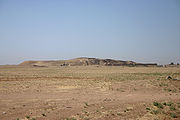
Tell Beydar
Encyclopedia
Tell Beydar in modern Al-Hasakah Governorate, Syria
, was the Ancient Near Eastern
city of Nabada.
, now Tell Brak. After the Jezirah region was conquered by the Akkadians, Nabada became an outpost of that empire. The city was than abandoned until
re-occupied for a time circa 1400 BC by the Hurrians
and again in the Neo-Assyrian and Hellenistic periods.
 The central site of Tell Beydar covers about 25 hectares (61.8 acre). A much later 50 ha (123.6 acre) Hurrian/Neo-Assyrian site lies at the base of the tell. At the top of the tell there is a Hellenistic settlement. Tell Beydar has been excavated for 16 seasons since 1992 by a joint Syrian and European team made up of the European Centre for Upper Mesopotamian Studies and the Directorate-General of Antiquities and Museums
The central site of Tell Beydar covers about 25 hectares (61.8 acre). A much later 50 ha (123.6 acre) Hurrian/Neo-Assyrian site lies at the base of the tell. At the top of the tell there is a Hellenistic settlement. Tell Beydar has been excavated for 16 seasons since 1992 by a joint Syrian and European team made up of the European Centre for Upper Mesopotamian Studies and the Directorate-General of Antiquities and Museums
of Syria. The team leads are Marc Lebeau and Antoine Suleiman. A number of other institutions, including the Oriental Institute of the University of Chicago
have also participated. Besides the architectural and pottery findings from the excavation, almost 250 early cuneiform tablets and fragments were recovered, dating from the pre-sargonic period. The tablets are agricultural records for the most part, but do establish some synchronisms with Tell Brak. The language used in the tablets is a variant of the Semitic Akkadian language
and the personal names referred to were also Semitic. A number of clay sealing have also been recovered. Finds from Tell Beydar are on display in the Deir ez-Zor Museum
.
Syria
Syria , officially the Syrian Arab Republic , is a country in Western Asia, bordering Lebanon and the Mediterranean Sea to the West, Turkey to the north, Iraq to the east, Jordan to the south, and Israel to the southwest....
, was the Ancient Near Eastern
city of Nabada.
History
Nabada was first settled during the Early Dynastic period circa 2600 BC. By around 2500 BC a medium sized independent city-state had developed. At that point, it became a provincial capital under the kingdom centered at NagarNagar, Syria
Tell Brak, ancient Nagar, is a tell, or settlement mound, in the Upper Khabur area in Al-Hasakah Governorate, northeastern Syria. The site was occupied between the sixth and second millennia BCE...
, now Tell Brak. After the Jezirah region was conquered by the Akkadians, Nabada became an outpost of that empire. The city was than abandoned until
re-occupied for a time circa 1400 BC by the Hurrians
Hurrians
The Hurrians were a people of the Ancient Near East who lived in Northern Mesopotamia and adjacent regions during the Bronze Age.The largest and most influential Hurrian nation was the kingdom of Mitanni. The population of the Hittite Empire in Anatolia to a large part consisted of Hurrians, and...
and again in the Neo-Assyrian and Hellenistic periods.
Archaeology

Directorate-General of Antiquities and Museums
The Directorate-General for Antiquities and Museums is a Syrian government directorate responsible for the protection, promotion and excavation activities in all sites of national heritage in Syria. The directorate was established shortly after Syria's independence in 1946...
of Syria. The team leads are Marc Lebeau and Antoine Suleiman. A number of other institutions, including the Oriental Institute of the University of Chicago
University of Chicago
The University of Chicago is a private research university in Chicago, Illinois, USA. It was founded by the American Baptist Education Society with a donation from oil magnate and philanthropist John D. Rockefeller and incorporated in 1890...
have also participated. Besides the architectural and pottery findings from the excavation, almost 250 early cuneiform tablets and fragments were recovered, dating from the pre-sargonic period. The tablets are agricultural records for the most part, but do establish some synchronisms with Tell Brak. The language used in the tablets is a variant of the Semitic Akkadian language
Akkadian language
Akkadian is an extinct Semitic language that was spoken in ancient Mesopotamia. The earliest attested Semitic language, it used the cuneiform writing system derived ultimately from ancient Sumerian, an unrelated language isolate...
and the personal names referred to were also Semitic. A number of clay sealing have also been recovered. Finds from Tell Beydar are on display in the Deir ez-Zor Museum
Deir ez-Zor Museum
The Deir ez-Zor Museum is a museum devoted to the archaeology and history of northeastern Syria, an area more commonly known as the Jezirah, or Upper Mesopotamia. The museum is located in Deir ez-Zor, the capital of Deir ez-Zor Governorate, Syria. It was founded in 1974 and housed in a gallery of...
.
Further reading
- Peter M. M. G. Akkermans, Glenn M. Schwartz, The Archaeology of Syria: From Complex Hunter-Gatherers to Early Urban Societies (c.16,000-300 BC), Cambridge University Press, 2004, ISBN 0521796660
- F. Ismail, W. Sallaberger, P. Talon, K. Van Lerberghe, Administrative Documents from Tell Beydar, Seasons 1993-1995, Brepols Publishers, 1997, ISBN 2503505392
- L. Milano, W. Sallaberger, P. Talon, K. Van Lerberghe, Third Millennium Cuneiform Texts from Tell Beydar, Seasons 1996-2002, Brepols Publishers, 2004, ISBN 2503515428
- Joachim Bretschneider, Nabada: The Buried City, Scientific American, vol. 283, pp 74-81, 2000
- K. Van Lerberghe and G. Voet, Tell Beydar: Environmental and Technical Studies, Brepols, 2001, ISBN 2503991211

